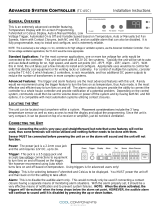
Pulse input/incremental encoder
An external, digital pulse transmitter used for feeding back
information on motor speed. The encoder is used in
applications where great accuracy in speed control is
required.
RCD
Residual current device.
Set-up
Save parameter settings in 4 set-ups. Change between the
4 parameter set-ups and edit 1 set-up, while another set-
up is active.
SFAVM
Switching pattern called stator ux-oriented asynchronous
vector modulation (14-00 Switching Pattern).
Slip compensation
The frequency converter compensates for the motor slip by
giving the frequency a supplement that follows the
measured motor load keeping the motor speed almost
constant.
SLC
The SLC (smart logic control) is a sequence of user-dened
actions executed when the associated user-dened events
are evaluated as true by the SLC. (Parameter group ).
STW
Status word.
FC standard bus
Includes RS485 bus with FC protocol or MC protocol. See
8-30 Protocol.
THD
Total harmonic distortion states the total contribution of
harmonic.
Thermistor
A temperature-dependent resistor placed on the frequency
converter or the motor.
Trip
A state entered in fault situations, for example if the
frequency converter is subject to an overtemperature or
when the frequency converter is protecting the motor,
process or mechanism. The frequency converter prevents a
restart until the cause of the fault has disappeared. Restart
the frequency converter to cancel the trip state. Do not
use the trip state for personal safety.
Trip lock
The frequency converter enters this state in fault situations
to protect itself. The frequency converter requires physical
intervention, for example when there is a short circuit on
the output. A trip lock can only be cancelled by discon-
necting mains, removing the cause of the fault, and
reconnecting the frequency converter. Restart is prevented
until the trip state is cancelled by activating reset or, in
some cases, by being programmed to reset automatically.
Do not use the trip lock state for personal safety.
VT characteristics
Variable torque characteristics used for pumps and fans.
VVC
+
If compared with standard voltage/frequency ratio control,
voltage vector control (VVC
+
) improves the dynamics and
the stability, both when the speed reference is changed
and in relation to the load torque.
60° AVM
60° asynchronous vector modulation (14-00 Switching
Pattern).
Power factor
The power factor is the relation between I
1
and I
RMS
.
Power factor =
3xUxI
1
cosϕ
3xUxI
RMS
The power factor for 3-phase control:
=
I1xcosϕ1
I
RMS
=
I
1
I
RMS
sincecosϕ1 = 1
The power factor indicates to which extent the frequency
converter imposes a load on the mains supply.
The lower the power factor, the higher the I
RMS
for the
same kW performance.
I
RMS
=
I
1
2
+ I
5
2
+ I
7
2
+ .. + I
n
2
In addition, a high-power factor indicates that the dierent
harmonic currents are low.
The DC coils in the frequency converters produce a high-
power factor, which minimises the imposed load on the
mains supply.
Safety regulations
1. Disconnect mains supply to the frequency
converter whenever repair work is to be carried
out. Check that the mains supply has been
disconnected and that the necessary time has
elapsed before removing motor and mains supply
plugs. For information about the discharge time,
see .
2. [O] does not disconnect the mains supply and
must not be used as a safety switch.
3. Ground the equipment properly, protect the user
against supply voltage, and protect the motor
against overload in accordance with applicable
national and local regulations.
4. The ground leakage current exceeds 3.5 mA.
Ensure the correct grounding of the equipment
by a certied electrical installer.
5. Do not remove the plugs for the motor and
mains supply while the frequency converter is
connected to mains. Check that the mains supply
has been disconnected and that the necessary
time has elapsed before removing motor and
mains plugs.
6. The frequency converter has more voltage
sources than L1, L2, and L3, when load sharing
Introduction
VLT
®
HVAC Drive FC 102
8 Danfoss A/S © 03/2015 All rights reserved. MG11CE02
1
1

























